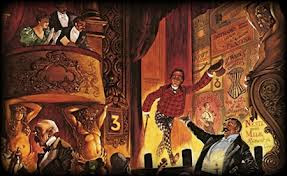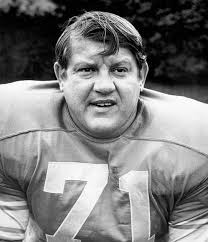Late
one December night in 1963 just before closing, Johnny Butsicaris was
tending bar while Alex Karras was sitting in a booth counting money and
doing some bookkeeping. Celebrated Detroit defense lawyer Joseph
Louisell came in and ordered a triple shot of bourbon, took off his
overcoat and scarf, and sat across from Karras.
 |
Defense lawyer Joseph Louisell
|
Louisell
was a popular customer at the Lindell AC. He was a heavy
set, jovial man who was well-read and an avid sports fan. Louisell was
known for winning some of Detroit's most notorious cases. He earned
respect for bringing acquittals or reduced sentences for many local
crime figures. He lived in the same Grosse Pointe Park neighborhood with
many of Detroit's top-ranking mob figures. Their kids even went to
school together.
"I
want to talk with you about your suspension, Alex. The NFL meets in
Miami next month. Have you made any plans regarding your reinstatement?"
"No, Rozelle wants me to drop my interest in the bar and I can't afford to do that."
"I've thoroughly checked out your bar activities.... You're as clean as snow."
"Tell that to Rozelle!"
"Give me the okay and I'll represent you."
"I can't afford you, Joe."
Over
65% of Joseph Louisell's law practice was devoted to civil and
corporate law. That's how he and partner Ivan Baris made their money,
but that bored Louisell. Joe would take some cases pro bono (free)
if they interested him. Winning several high-profile defense cases
helped build his reputation. Louisell was a diehard Lions fan, as
were other interested parties who wanted to see Karras back in a
Lions uniform, but they preferred to remain anonymous not wanting to prejudice the case against him.
"I'll take your case pro bono. I want to see you back on the gridiron, Alex. Here's my argument."
Louisell
cited a provision in Michigan liquor licensing that states if your name
appears on a Michigan liquor license, you can't sell your business for
one year--by law. That includes taverns and liquor stores.
"What does that mean for me?"
"Were you to sell your interest in the bar business, you can 't get
another liquor license for three years. We can sue them for lost wages
if they force you to sell your stake in the Lindell, and they don't reinstate you."
Louisell
told Alex to quit working at the bar, return to his family in Clinton,
Iowa, maintain a low profile, and most of all, do not speak with the press. "Wait for my phone call," Louisell emphasized. In late January, Louisell made sure
Karras' formal reinstatement appeal was on Commissioner Pete Rozelle's
desk.
 |
NFL Commissioner Pete Rozelle
|
In
early March, Louisell and Karras went to meet with Commissioner Rozelle
at his New York offices. After waiting for almost an hour in a
reception room, the two men were led into the commissioner's office
where Rozelle on the phone ignored them for some minutes.
With Karras about to storm out of the office in frustration, Louisell
calmed him down and told Rozelle to get off the phone, "This man's
life is important."
Cutting short his phone call, Rozelle said, "Okay, Mr. Louisell, I'm listening."
Louisell explained that gambling is as intrinsic to professional football
as the two-pointed pigskin, and Rozelle knew it. NFL football gambling
existed on every level of American society and occurred weekly in office
and factory pools, in Las Vegas sports betting parlors, and with private
wagers made by John Q. Public--most of it innocent enough.
"You've
unjustly punished Alex Karras for a year. My advice to you is make a
decision within a week. If it's negative, I will tear the NFL apart."
Louisell and Karras rose promptly from their seats and left the commissioner to
think it over.
Rozelle knew any bad publicity with a headline-hungry
press was not good for the league. He also knew that Louisell was not some ambulance-chasing shyster. His client list included many of Detroit's most notorious power-players including Jimmy Hoffa and the Giacoloni brothers. The last thing the NFL wanted was a media circus broadcast nationwide.
On March 16, 1964, both Green Bay Packer Paul Horning and Detroit Lion Alex
Karras were reinstated. The NFL issued a statement saying both men bet
on football games but never against their own teams, and there was no
evidence either man performed less than his best in any football game.
"After personal discussions with each man, the commissioner is
satisified that they have a clear understanding of the seriousness of
their offenses," said an NFL spokesman. Nothing was mentioned about
Karras' co-ownership of the Lindell AC sports bar.
***
In a 1969 interview with Sport magazine
writer Lou Proto, Karras was led into the subject of his 1963
suspension. "It is my understanding," said Proto, "that you had to sell
your interest in the Lindell AC when ordered by Pete Rozelle."
"I kept it for five more years."
"How did you manage that?"
"It
was a verbal thing. If Rozelle would have claimed something illegal was
going on at the Lindell, he would have been slapped with a lawsuit."
"Then, you were lying when you told Rozelle in 1964 that you sold your interests in the bar?"
"Lying to whom? The guy who was trying to screw me?"
Karras was outspoken but not altogether candid in the interview. He didn't care; he knew the
end of his football career was near, and he had already shifted his career
trajectory into show business by signing a contract with Hannah-Barbera
Productions--already appearing in the TV series Daniel Boone with Fess Parker and a western named The Hard Case with Clint Walker.
 |
William Clay Ford
|
Recently, Mel Butsicaris revealed to me what really happened. His father Johnny went to see Lions owner William (Bill) Clay Ford. He told Bill Ford if he ever wanted to see Karras in a Lions' uniform again, he needed to lend him and his brother Jimmy the money to buy out Karras' share of the Lindell. They put up their sports bar as security, cut a deal, and Ford had his lawyers write up the promissory note. It took the Butsicaris brothers five years to pay off the loan.
"My dad paid the last installment to Bill Ford personally and took the promisory note, twisted it up, and set one end on fire to light his cigar."
Although I can appreciate the symbolic gesture, the researcher in me regrets that this piece of documentation when up in smoke.
More background on Joseph Louisell
Karras NFL Suspension--Part One
Karras NFL Suspension--Part Two


















